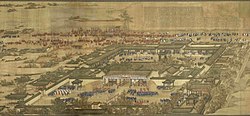Hanlin Akademiyası
Hanlin Akademiyası (çin. 翰林院) ― VIII əsrdə Tan sülaləsinin imperatoru Hsüançunq tərəfindən Çanqanda qurulmuş akademik və inzibati ali təhsil müəssisəsi idi. Akademiyaya üzvlük saray üçün katiblik vəzifələri yerinə yetirən elit bir qrup alimlə məhdudlaşırdı. Onun əsas vəzifələrindən biri Çin klassiklərinin təfsirinə qərar vermək idi. Bu, hökumət bürokratlarının daha yüksək səviyyəli dövlət vəzifələrinə çatmaq üçün keçməli olduğu imperiya imtahanlarının əsasını təşkil etdi. Sarayda işləyən rəssamlar da akademiyanın üzvü idi.
| Hanlin Akademiyası | |
|---|---|
| 翰林院 | |
 1744-cü ildə Hanlin | |
| Əsası qoyulub | 708 |
| Bağlanıb | 1911 |
| Tip | Akademiya |
| Şəhər | Çanqan, Loyan, Pekin, Nankin |
| Ölkə | |
Min sülaləsi dövründə, 1407-ci ildə akademiya nəzdində Tərcüməçilər Bürosu yaradılmışdı.[1] Bu büroda tunqus[2][3], monqol[4], koreya[5], ryükyü, yapon[6][7], tibet[8], fars[9], Vyetnam[10], Myanmar dillərini öyrənən şöbələr təşkil edilmişdi. Daha sonra bu büroya Qədim Uyğur dili[4] və Sanskrit şöbələri də əlavə edildi. 1511 və 1579-cu illərdə Lao və Tay dilləri əlavə edildi.[11] Malay dili[12] və Çam dili[13] də sonradan artırıldı.
Akademiya 1911-ci ildəki Sinxay inqilabınadək fəaliyyətini davam etdirdi.
İstinadlar
[redaktə | mənbəni redaktə et]- ↑ Wild, Norman. "Materials for the Study of the Ssŭ i Kuan 四 夷 譯 館 (Bureau of Translators)". Bulletin of the School of Oriental and African Studies, University of London. 11 (3). 1945: 617–640. doi:10.1017/S0041977X00072311. JSTOR 609340.
- ↑ de Lacouperie, Terrien. "The Djurtchen of Mandshuria: Their Name, Language, and Literature". Journal of the Royal Asiatic Society of Great Britain and Ireland. 21 (2). 1889: 433–460. JSTOR 25208941.
- ↑ Shou-p'ing Wu Ko. Translation (by A. Wylie) of the Ts'ing wan k'e mung, a Chinese grammar of the Manchu Tartar language (by Woo Kĭh Show-ping, revised and ed. by Ching Ming-yuen Pei-ho) with intr. notes on Manchu literature. 1855. xix–.
- ↑ 1 2 Morris Rossabi. From Yuan to Modern China and Mongolia: The Writings of Morris Rossabi. BRILL. 28 November 2014. 98–. ISBN 978-90-04-28529-3.
- ↑ Ogura, S. "A Corean Vocabulary". Bulletin of the School of Oriental Studies, University of London. 4 (1). 1926: 1–10. doi:10.1017/S0041977X00102538. JSTOR 607397.
- ↑ Mai, Yun. "漢語歷史音韻研究中的 一些方法問題 [Some Methodological Problems in Chinese Phonetics]". 浙江大学汉语史研究中心简报 [The Briefing News of Research Center for History of Chinese Language]. 18 (2). 2005. İstifadə tarixi: 24 May 2020.
- ↑ Chiu, Chichu. 中國翻譯史學會論文投稿: 16世紀日本譯語的出版及傳抄 [The Publishing and Writing of Chinese-Japanese Dictionary in the 16th Century]. 書寫中國翻譯史:第五屆中國譯學新芽研討會 [Writing Chinese Translation History: Fifth Young Researchers’ Conference on Chinese Translation Studies] (çin). 21 December 2012. İstifadə tarixi: 24 May 2020.
- ↑ Lotze, Johannes S. Translation of Empire: Mongol Legacy, Language Policy, and the Early Ming World Order, 1368-1453 (PDF) (PhD). 2016. 29 July 2022 tarixində arxivləşdirilib (PDF). İstifadə tarixi: 24 May 2020.
- ↑ Ido, Shinji. Chapter 2: Huihuiguan zazi: A New Persian glossary compiled in Ming China // Trends in Iranian and Persian Linguistics. De Gruyter Mouton. 2018. 21–52. doi:10.1515/9783110455793-003.
- ↑ "Thông báo về việc các GS Nhật Bản sang trao đổi khoa học, tham gia đào tạo cao học Hán Nôm" (PDF). 2016-03-09 tarixində orijinalından (PDF) arxivləşdirilib. İstifadə tarixi: 2016-01-22.
- ↑ Norman Wild, "Materials for the Study of the Ssŭ i Kuan 四夷(譯)館 (Bureau of Translators)", Bulletin of the School of Oriental and African Studies, University of London, 11 (3), 1945: 617–640, doi:10.1017/s0041977x00072311, JSTOR 609340; pp. 617-618.
- ↑ Vladimir Braginsky. Classical Civilizations of South-East Asia. Routledge. 18 March 2014. 366–. ISBN 978-1-136-84879-7.
- ↑ Edwards, E. D.; Blagden, C. O. "A Chinese Vocabulary of Cham Words and Phrases". Bulletin of the School of Oriental Studies, University of London. 10 (1). 1939: 53–91. JSTOR 607926.